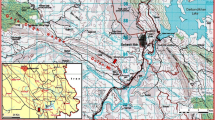Abstract
The Qom Formation (Late Oligocene-Early Miocene?) to the north of Nain along the southern trend of the central Iranian Basin represents a carbonate-marl depositional system. Upward, the predominant microfacies are sandstone (litharenite); reworked lithobioclastic grainstone, bioclastic packstone to wackestone with the larger benthic foraminifera and mollusks; bioclastic packstone to wackestone with the smaller foraminifera; bryozoa grainstone; and peloid and miliolid wackestone.
Microfacies analysis and facies interpretations suggest that the dominant environments were marginal to restricted open marine, open marine to restricted marine and bar; and open marine to lagoon and nearshore.
Three depositional sequences were also recognized. These sequences are characterized by the retrograding and aggrading stacking patterns of transgressive and highstand system tracts, respectively. A marginal prograding stacking pattern of lowstand system tracts was also recognized at the base. Sequence boundaries were characterized by either an abrupt change in lithology or by superposition of transgressive beds upon aggrading ones. Maximum flooding surfaces were coincident with deepening and shallowing in each depositional sequence.
Similar content being viewed by others
References
BERBERIAN, M., 1983, Continental deformation in the Iranian Plateau. Contribution to the seismotectonics of Iran, Part IV:Geological Survey of Iran, Report no. 52.
BOZORGNIA, F., 1966, Qom Formation, stratigraphy of the Central basin of Iran and its intercontinental position:Bulletin of Iranian Petroleum Institute, no. 24, p. 69–76.
CAROZZI, A.V., 1989, Carbonate rocks depositional model. Prentice Hall, New Jersey, 604 p.
CHOQUETTE, P.W. and PRAY, L.C., 1970, Geological nomenclature and classification of porosity in sedimentary carbonates:American Association of Petroleum Geologists Bulletin, v. 54, p. 205–250.
DAVOUDZADEH, M., 1972, Geology and petrography of the area north of Nain, Central Iran:Geological Survey of Iran, no. 14, 89 p.
DUNHAM, R.J., 1962, Classification of carbonates rocks according to depositional texture. American Association of Petroleum Geologists Memoir, no. 1, p. 105–121.
FLÜGEL, E., 1982, Microfacies analysis of limestones. Springer, Berlin-Heidelberg-New York, 633 p.
FRIEDMAN, G.M. and SANDERS, J.E., 2000, Comments about the relationships between new ideas and geologic terms in stratigraphy and sequence stratigraphy with suggested modifications:American Association Petroleum Geologists Bulletin, v. 84, p. 1274–1280.
FURRER, M.A. and SODER, P.A., 1955, The Oligo-Miocene marine formation in the Qom region (Central Iran):Geological Survey of Iran, no. 132, 48 p.
GEEL, T., 2000, Recognition of stratigraphic sequence in carbonate platform and slope, empirical models based on microfacies analysis of Paleogene deposits in southeastern Spain:Palaegeography, Palaeoclimatology, Palaeoecology, v. 155, p. 211–238.
GEOLOGICAL SURVEY OF IRAN, 1969, Nain Map, no. 14.
HAMEDANI, A., WIELANDT, U. SCHUSTER, F., and MANDIC, O., 1998, Oligocene-Miocene shallow marine biofacies of Central Iran, Tertiary to Recent larger foraminifera. Kingston University, Kingston Hill Center, p. 14–19.
KALANTARY, A., 1986, Microfacies of carbonate rocks of Iran. Geological Laboratory Publication, National Iranian Oil Company, Tehran, v. 11, 520 p.
LOEBLICH, A.R. and TAPPAN, H., 1988, Foraminiferal genera and their classification. Chapman and Hall, 1728 p.
MIALL, A.D., 2000, Principles of sedimentary basin analysis. Springer, Berlin-Heidelberg-New York, p. 326–327.
NATIONAL IRANIAN OIL COMPANY, 1977, Geological Map of Iran, sheet no. 1–6.
NOGOL-E-SADAT, M.A.A., 1985, Les zones de decrochement et les virgation structurales en Iran, Consequences des resultates de analyse structurale de la région de Qom. Geological Survey of Iran, Report no. 55, p. 8–14.
POSAMENTIER, H.W. and VAIL, P.R., 1988, Eustatic control on clastic deposition, II, sequence and system tract models.In C.K. Wilgus, B.S. Hastings, C.G.St.C. Kendall, H.W. Posamentier, C.A. Ross, and J.C. Van Wagoner, eds., Sea Level Changes: An Integrated Approach, Special Publication, Society of Economic Paleontologists and Mineralogists, v. 42, p. 125–154.
RAHIMZADEH, F., 1994, Oligo-Mio-Pliocene of Iran. Geological Survey of Iran, 311 p.
SAJJADI, H.F., 1990, Stratigraphy, micropaleontology and petrography of the rocks in the area between Natanz-Ardestan, Central Iran. Unpublished MSc Thesis, University of Tehran, 178 p.
SARG, J.F., 1988, Carbonate sequence stratigraphy.In C.K. Wilgus, B.S. Hastings, C.G.St.C. Kendall, H.W. Posamentier, C.A. Ross, and J.C. Van Wagoner, eds., Sea Level Changes: An Integrated Approach, Special Publication, Society of Economic Paleontologists and Mineralogists, v. 42, p. 155–181.
SCHOLLE, P.A., ARTHUR, M.A., and EKDALE, A.A., 1983, Pelagic environment. American Association Petroleum Geologist Memoir, no. 33, 620 p.
SCHUSTER, F. and WIELANDT, U., 1999, Oligocene and Early Miocene coral faunas from Iran, Palaoecology and Palaeobiogeography Institute:Journal of Earth Sciences, v. 88, p. 571–581.
SLOSS, L.L., 1963, Sequence in the cratonic interior of North America:Geological Society of America Bulletin, v. 76, p. 93–114.
STAHL, A.F., 1911, Persian handb. D. region:Geologie, v. 5, no. 8, Heidelberg.
STOCKLIN, J., 1968, Structural history and tectonics of Iran:American Association of Petroleum Geologists Bulletin, v. 52, no. 7, p. 229–258.
STOCKLIN, J. and SETUDEHNIA, A.A.O., 1977, Stratigraphic Lexicon of Iran. Geological Survey of Iran, Report no. 18,
TIETZE, E., 1875, Ein Ausflug nach dem Siaskuh (Schwarzer Berg) in Persien, Mitteilung Geography Gesellschaft, Wien, n. s., v. 18, no. 8, p. 257–267.
VAIL, P.R., MITCHUM, R.M., and THOMPSON, JR.S., 1977, Seismic stratigraphy and global changes of sea level.In C.E. Payton, ed., Seismic stratigraphy, Application to Hydrocarbon Exploration. Memoir of the American Association of Petroleum Geologists, v. 26, p. 63–81.
VAN WAGONER, H.W., POSAMENTIER, J.C., and MITCHUM, RM., JR. ET. AL., 1988, An overview of the fundamentals of sequence stratigraphy and key definition.In C.K. Wilgus, B.S. Hastings, C.G.St.C. Kendall, H.W. Posamentier, C.A. Ross, and J.C. Van Wagoner, eds., Sea level changes: An Integrated Approach, Special Publication, Society of Economic Paleontologists and Mineralogists, v. 42, p. 39–45.
WILSON, J.L., 1986, Carbonate facies in geologic history. Springer-Verlag, New York, 471 p.
WRIGHT, V.P., 1992, A revised classification of limestones:Sedimentary Geology, v. 76, p. 177–185.
Author information
Authors and Affiliations
Rights and permissions
About this article
Cite this article
Seyrafian, A., Toraby, H. Petrofacies and sequence stratigraphy of the Qom Formation (Late Oligocene-Early Miocene?), north of Nain, southern trend of central Iranian Basin. Carbonates Evaporites 20, 82–90 (2005). https://doi.org/10.1007/BF03175451
Published:
Issue Date:
DOI: https://doi.org/10.1007/BF03175451




